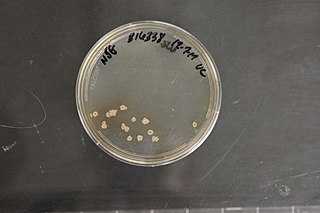Granulicoccus phenolivorans is a Gram-positive and phenol-degrading bacterium which has been isolated from phenolic wastewater in Singapore.

Allokutzneria albata is a bacterium from the genus Allokutzneria which has been isolated from soil from the Mindanao Island on the Philippines. Allokutzneria albata produces the antivirals cycloviracin B1 and cycloviracin B2 as well as the antibiotic sequanamycin A (SEQ-503), a 14-membered ring erythromycin family macrolide against Mycobacterium tuberculosis, which was discovered in 1969.
Allokutzneria multivorans is a bacterium from the genus Allokutzneria which has been isolated from soil from a river bank from the Nujiang River in Yunnan, China.
Allokutzneria oryzae is a bacterium from the genus Allokutzneria which has been isolated from the rhizospheric soil from the rice-plant.
Goodfellowiella coeruleoviolacea is a bacterium from the family Pseudonocardiaceae which has been isolated from soil in Russia.
Kibdelosporangium is a Gram-positive genus from the family of Pseudonocardiaceae. Kibdelosporangium bacteria produce substances with antibacterial, anticancer, and antiviral activities.
Lentzea flava is a bacterium from the genus Lentzea which has been isolated from soil. Lentzea flava produces madumycin.
Lentzea is a Gram-positive, mesophilic and aerobic genus from the family Pseudonocardiaceae.
Lentzea kentuckyensis is a bacterium from the genus Lentzea which has been isolated from a placenta of an Equine in Lexington.
Lentzea californiensis is a bacterium from the genus Lentzea which has been isolated from soil in California.
Clostridium bowmanii is a psychrophilic, Gram-positive, anaerobic and spore-forming bacterium from the genus Clostridium.
Clostridium frigoris is a Gram-positive, rod-shaped, and spore-forming bacterium from the genus Clostridium. It is a psychrophile, with optimal growth conditions at 5–7 °C.
Clostridium lacusfryxellense is a psychrophilic, Gram-positive, spore-forming and anaerobic bacterium from the genus Clostridium which has been isolated from a microbial mat from Lake Fryxell in Antarctica.
Cellulomonas aerilata is a Gram-positive, aerobic and motile bacterium from the genus Cellulomonas which has been isolated from air from Suwon in Korea.
Glycomyces algeriensis is a bacterium from the genus of Glycomyces which has been isolated from soil from a potato field in Algeria.
Glycomyces arizonensis is a bacterium from the genus of Glycomyces which has been isolated from soil from a kangaroo rat burrow from Arizona in the United States.

Stackebrandtia is a Gram-positive, aerobic and non-motile genus of bacteria from the family of Glycomycetaceae. Stackebrandtia is named after the German microbiologist Erko Stackebrandt.

Stackebrandtia nassauensis is a bacterium from the genus of Stackebrandtia which has been isolated from soil from a roadside from Nassau in Puerto Rico.
Sneathiella chinensis is a Gram-negative, aerobic, non-spore-forming, chemoheterotrophic, halotolerant and motile bacterium from the genus of Sneathiella which has been isolated from coastal sediments from Qingdao in China.
Mycetocola reblochoni is a Gram-positive, aerobic, non-spore-forming and rod-shaped bacterium from the genus Mycetocola which has been isolated from the surface of Reblochon cheese.


